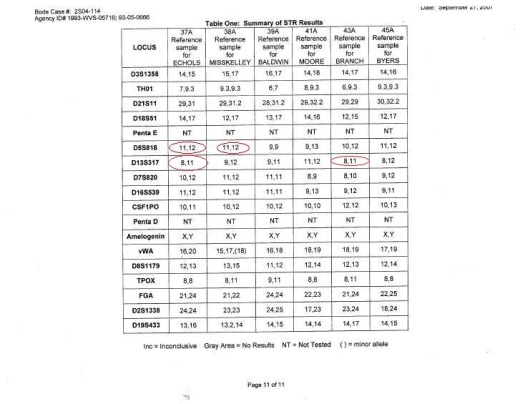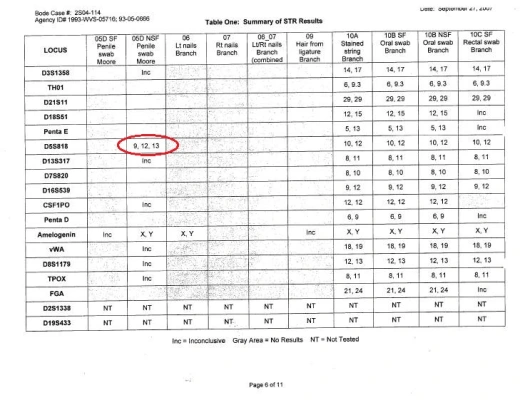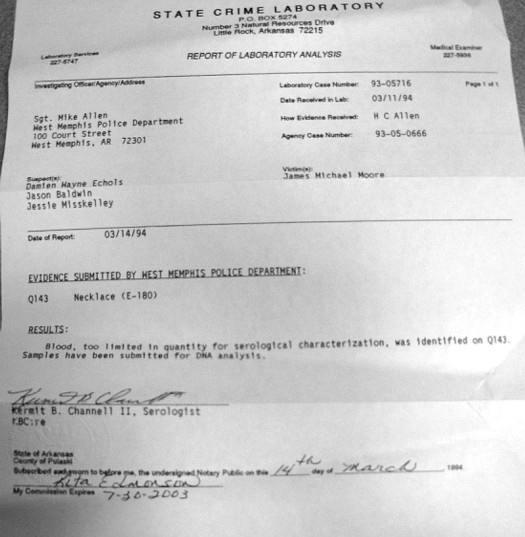A controversial element to the crime, or at least controversial to supporters of the WM3 was that of the three sticks recovered by investigators at the crime scene, with many supporters refusing to believe that they may have been murder weapons as the prosecution contended, or that they had entirely no relevance to the crime alleging that because two of them were not recovered from the crime scene on the day the bodies were discovered, that they held no connection to the homicides.
The Discovery of E-138 and E-139—

(E-139, a large stick that was recovered near the body of Michael Moore.)
According to Det. Bryn Ridge, that as he was searching the ditch for evidence, approaching the location where Michael Moore’s body was discovered, a stick that was shoved down into the mud had come free and floated to the surface. The stick was shoved straight down into the bottom of the ditch with a shirt from one of the victims wrapped around it.
Testimony on the matter was elicited by Deputy Prosecutor John Fogleman at trial:
Ridge: This item is a stick that – when Sergeant Allen told me he had located the body and pointed out the area where the body had been located, I was up on the west bank which is a high bank. Ok. I proceeded to the north, come down into the creek, and began walking down into the creek and searching that creek. In searching the creek, I would start in the waterline on one side, rake all the way through and get back on the other side – see if anything was there before I would walk through that area, which could possibly destroy any evidence. Ok. I had walked approximately 10 feet and gotten almost to that body when this stick was uh – dislodged and when it came floating up out of the water uh – this shirt was discovered, and the shirt was wrapped around the end of the stick –
Fogleman: Ok.
Ridge: – and all that was jabbed down into the mud in the bottom of the ditch.
Fogleman: Alright. Now when you say it was dislodged when you were walking toward that area, what if anything could you see about that stick?
Ridge: Just the end of the stick sticking up out of the water.
This stick was documented in several crime scene photos due to the fact that it was near the body of Michael Moore and had a shirt wrapped around it. It was not originally taken in as evidence as it was unknown what the murder weapon was at that time and no autopsy had yet been done. Eventually weeks later, using photos of the crime scene, investigators recovered this stick, labeling it as E-139 and also recovered a second stick next to it as another possible weapon which they labeled as E-138.
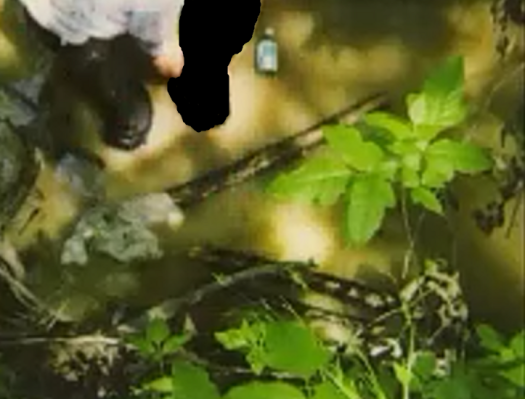
(Photo of investigators discovering E-139 as they pull the body of Michael Moore from the ditch.)
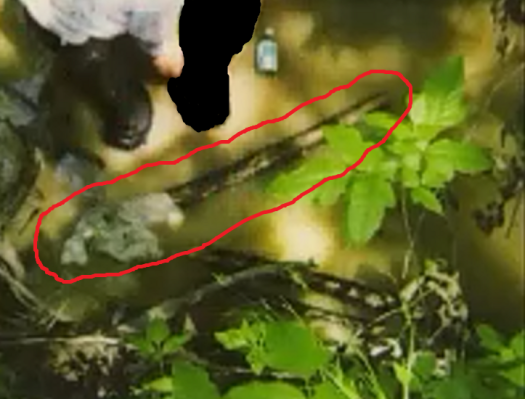
(E-139 highlighted in the above image.)
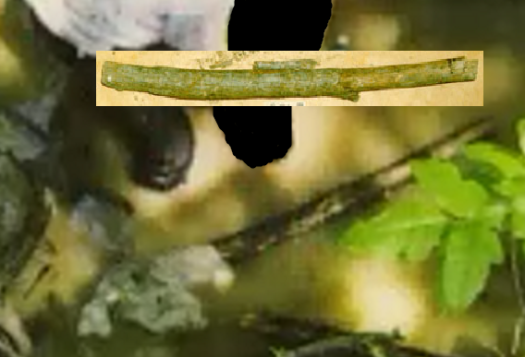
(A visual comparison between the recovered stick known as E-139 and that of the stick shown in the ditch.)
As stated above, Bryn Ridge discovered the stick which he noticed particularly because a shirt had been wrapped around it, indicating that the killer or killers had more than likely had contact with it, an observation not made at the time.
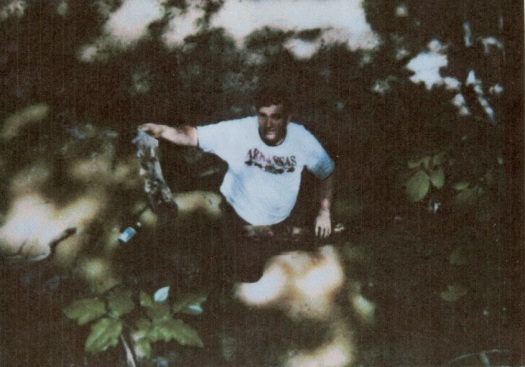
(Victim T-shirt being removed from the end of E-139.)
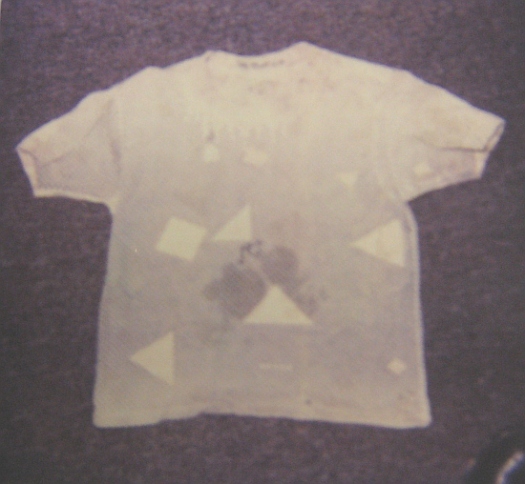
(Shirt removed from E-139.)
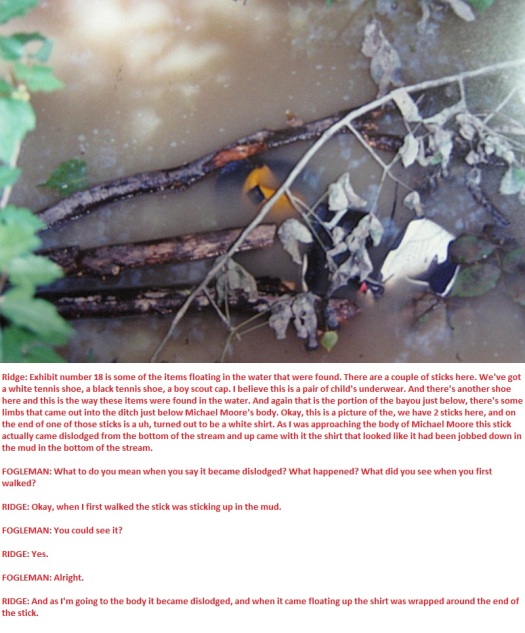
(Testimony along with the corresponding photo depicting the discovery of E-138 and E-139.)
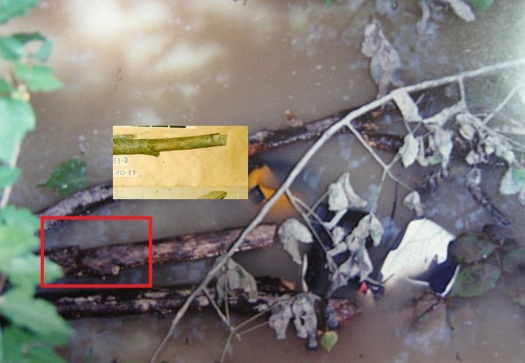
(Comparison image with a photo of E-139 again demonstrating that the stick pictured is the same one in the crime scene photos from the day the bodies were discovered.)
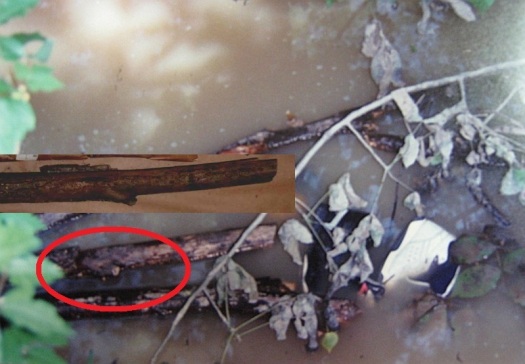
(Another comparison photo with E-139, again showing that it is the same stick that was recovered.)
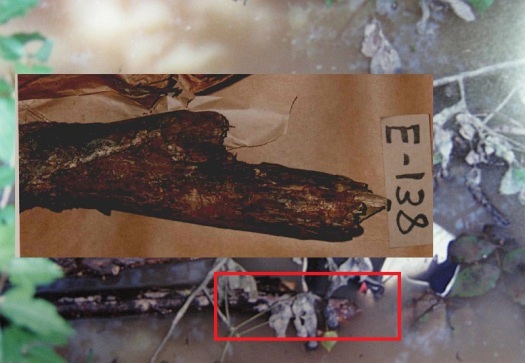
(Comparison photo showing that E-138 is indeed the stick seen floating next to E-139 in the above photo.)
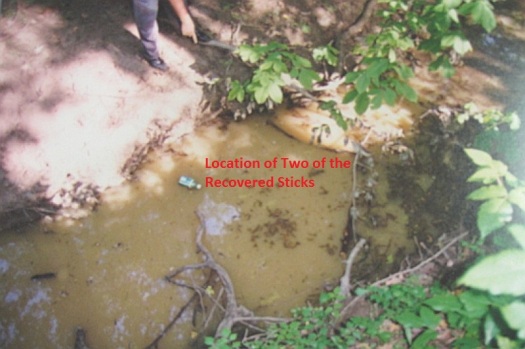
(Where the two sticks were located. This location is directly in front of what became known as the “slicked off” ditch bank which was the same location where Moore’s body was discovered.)
Neither of these two sticks were taken into evidence on the day the bodies were discovered. They were initially missed as evidence despite the significance of E-139 having the shirt wrapped around it, which again indicated that it had been handled by whoever killed the boys.
As for E-138, it was a similarly large stick found directly next to E-139, but was more dubious as there was nothing that directly demonstrated a connection between it and the murders in the same manner that E-139 did. It was recovered because it was directly next to E-139 under the premise that E-139 was a murder weapon and therefore E-138 might have been as well.
Following the confession of Jessie Misskelley, Ridge returned to the crime scene and recovered E-138 and E139, the sticks he had discovered and neglected to take into custody on the day the bodies were discovered.
INVESTIGATIVE REPORT
TRIPLE HOMICIDE
BYERS/MOORE/BRANCHON 070193, I WENT TO THE CRIME SCENE TO DETERMINE IF ANY EVIDENCE COULD BE FOUND THAT HAD BEEN OVERLOOKED DURING THE INITIAL SEARCHES OF THE AREA THAT THE ABOVE NOTED HOMICIDE. WHILE AT THE SCENE AND THINKING ABOUT THE CASE SO FAR AND THE STATEMENTS THAT HAD BEEN MADE BY THE DEFENDANT JESSIE MISSKELLEY JR. I DISCOVERED THAT THERE WERE TWO STICKS ON THE SCENE THAT HAD GONE PREVIOUSLY UNDETECTED. IN THE STATEMENT THAT JESSIE HAD GIVEN HE DESCRIBED A STICK THAT HAD BEEN USED BY ONE OF THE CO-DEFENDANTS TO BEAT THE VICTIMS ON THE HEAD WITH. I SEIZED THE STICKS AND BROUGHT THEM TO THE POLICE DEPARTMENT TO BE SENT TO THE CRIME LAB FOR ANALYSIS TO DETERMINE IF THEY COULD HAVE BEEN THE SAME AS JESSIE STATED HAD BEEN USED TO BEAT THE VICTIMS. THE STICKS WERE PLACED IN THE EVIDENCE FILES AND WILL BE SENT TO THE CRIME LAB UNDER NUMBERS E-138 AND E-139.
DETECTIVE B. RIDGE
WEST MEMPHIS POLICE DEPARTMENT
THE DISCOVERY OF E-17—
The third and final stick recovered was E-17, the only stick to be taken into evidence immediately at the crime scene, due to the fact that it appeared to have parts of it carved off or missing. It was found floating around the location of the bodies of Chris Byers and Stevie Branch.
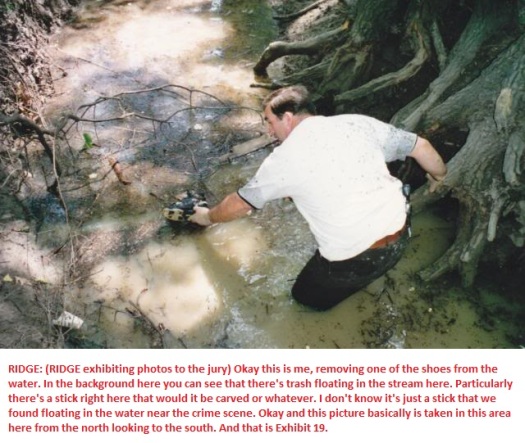
(Discovery of E-17 with testimony on it’s discovery.)
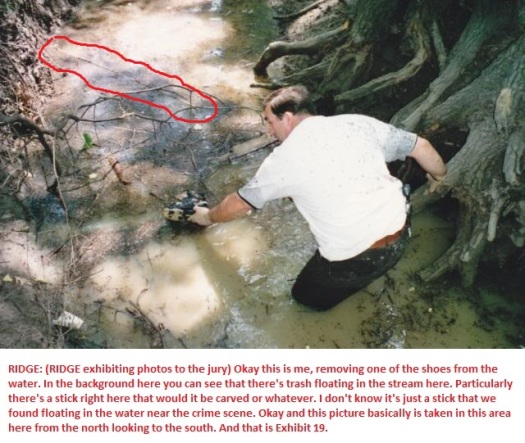
(E-17 highlighted in the discovery photo above.)
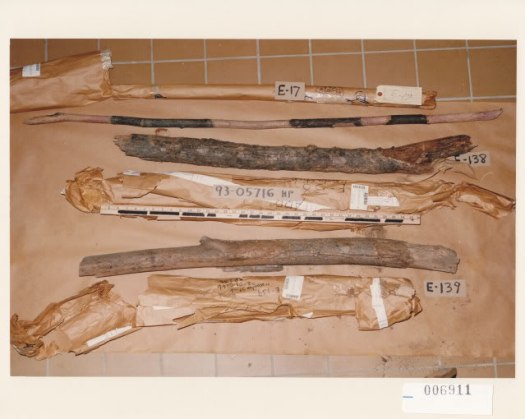
(All three sticks in evidence.)
THE STICKS AS WEAPONS—
Testimony was given both at trial and during appeals that it appeared as if two different weapons were used to strike Michael Moore in the head. On the left side of his head were several injuries that appeared like thin lines, which were inflicted with a weapon that was consistent with a thin stick like E-17.
From the trial of Jessie Misskelley, Dr. Frank Peretti stated the following under questioning by Prosecutor Brent Davis:
Peretti: Ok. State’s exhibit 59A, 62A, 61A, 63A will demonstrate the head injuries and some of the chest injuries. State’s exhibit 59A shows a laceration over the left forehead region and also we can see an abrasion. When I talk about abrasions, I’m going to be using the terms–abrasion means a scrape or a scratch and a contusion means a bruise, in layman’s terms black and blue. Here we can see, on the left side, we can see the laceration and also we can see an abrasion on the right side of the forehead. State’s exhibit 62A is a view of the head showing the left side and here we can see…
Brent Davis: [interrupting] Doctor, excuse me just a second, was the hair shaved back so that could be photographed?
Peretti: Yes. I shaved the hair. Here we can see three impact points on the scalp. We have three separate scalp lacerations surrounded by an abrasion and contusions surrounding the wound. Above the eyebrow, we have an abrasion immediately adjacent to the eyebrow or scrape and also on this photograph, we can see a bruise or contusion noted below the left eye, this dark discoloration here. On State’s exhibit 61A, we have two abrasions or scrapes on the top of the head, that ovoid-we have two separate impact sites here.
Davis: Now Doctor, I notice that the injuries depicted in exhibit…what number is that?
Peretti: 61A.
Davis:…61A are different than those that appear in the previous exhibit 62A?
Peretti: That’s correct.
Davis: Can you explain to the ladies and gentlemen of the jury, based on your experience and expertise in this field, why we have different type injuries?
Peretti: Well, we have two different instruments–weapons are being used, inflicting these type of injuries.
Davis: And when you say–what type of instrument would you expect to be used or a general description of the type of instrument that would inflict the injury in 61A, I believe?
Peretti: On 61A, we’re looking for an object with a broad surface–wide surface area.
Davis: Doctor, would that be consistent with say a log aproximately 2 to 3 or 3 to 4 inches in diameter?
Peretti: An object of that nature is consistent with inflicting these type of injuries.
Davis: Okay. Now the injuries that you see in photograph number 62A, you said it would have been inflicted by a different type weapon. What could have caused that? Or what type of instrument would you expect to cause those injuries?
Peretti: Well, this wound has different characteristics than the previously shown wound. Here we have lacerations, or in laymen’s terms cuts, on the scalp that are somewhat irregular. Some are straight, some have a stellate appearance and these type of injuries here indicate an object of a smaller diameter such as, you know, a piece of wood, a 2 by 4, a stick or broom handle are capable of inflicting these type of injuries here.
Davis: So, something about the size of a broom handle?
Peretti: Yes.
Below are links to photos of these injuries, which are shown here due to their relevant case value.
Located on the left side of Michael Moore’s head were several thin impact injuries which broke the skin on his head.
WARNING! Autopsy photo! WARNING!
Located on the right side of Moore’s head were a couple of very different injuries that were large and semi-circular in appearance, which were consistent with a large stick or log having struck him, such as E-139; the stick located near his body with the shirt wrapped around it.
WARNING! Autopsy photo! WARNING!
In the next photo, it shows the same injuries underneath the skin. It can plainly be seen that there are circular injuries creating a more clear pattern onto the skull.
WARNING! Autopsy photo! WARNING!
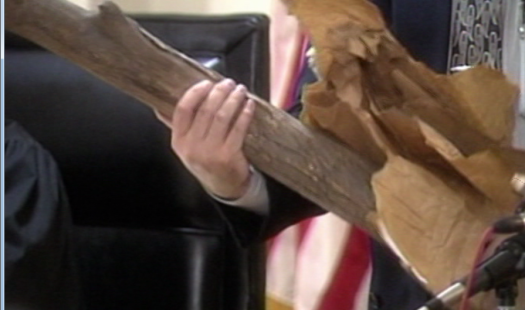
(E-139 presented in court. It was a likely murder weapon used in the death of Michael Moore.)
Dr. Terri Haddix, a Forensic Pathologist consulted with by the defense, stated in her own report from October 22, 2007 the following on the injuries to Moore’s head, particularly these circular fractures:
“The items potentially responsible for producing the scalp contusions, abrasions and lacerations are legion and the appearence of the cutaneous injuries doesn’t particularly help narrow the field. However, the curvilinear skull fractures identified during Moore’s autopsy are suggestive of an object with a similar curvilinear profile.”
Haddix states what you can see with your own two eyes when it comes to the wounds on the right side of his head, that the weapon that created the large circular fractures must also be similar in shape; having a rounded shape. This in turn further demonstrates that E-139 is the likely weapon responsible for those injuries.
The next relevant injury for this discussion is yet another thin line like injury found on the top of Chris Byers’ head, again consistent with being inflicted with a weapon such as E-17.
WARNING! Autopsy photo! WARNING!
And finally, Stevie Branch, who also had injuries from being beaten with an object also had a pattern on his thigh, from which it appeared he had been restrained with a long thin object consistent with E-17.
WARNING! Autopsy photo! WARNING!
During questioning by John Fogleman at trial it was heavily suggested by Det. Gary Gitchell that in his opinion from working at the crime scene, that a stick, likely E-17 had created the clear pattern on Stevie’s thigh.
Q: Do you know whether or not – – are you aware of any evidence that would indicate that there had been some sort of binding other than the shoestrings?
A: Some markings of their legs.
MR. STIDHAM: I’m going to object to that. He’s not the medical examiner.
MR. Fogleman: He can state what he observed.
THE COURT: Are you testifying from reports, records or from your own personal observation?
THE WITNESS: From my own observation.
THE COURT: Overruled.
BY MR. Fogleman:
Q: I want to show you State’s Exhibit 59B, the mark across the leg here. Did you observe that?A: Yes, sir.
Q: What did you observe?
A: Well, the – –
MR. STIDHAM: May I interpose another objection? Your Honor, I think that calls for pure unadulterated speculation on the part of this witness who is not qualified to render such an opinion.
MR. Fogleman: Your Honor, I asked him what he observed.
THE COURT: I’m going to allow him to testify to what he observed on the victims’ bodies. I’m not going to let him speculate as to the cause of the observation. Your objection will be sustained in that regard. He may testify to what he personally observed.
BY MR. Fogleman:
Q: What did you observe?A: I observed this bruising. I believe it was on the left leg stretching approximately three and a half inches of the leg.
Q: Did you observe a pattern?
A: Yes, sir, it appears to be of a – –
MR. STIDHAM: Your Honor, again, that calls for pure speculation. Why didn’t they ask the Medical Examiner yesterday when he was here? He may be qualified to answer that question.
MR. Fogleman: Your Honor, I think – –
THE COURT: I cannot respond to why they didn’t ask somebody something, but I’m going to let this (p. 957) witness testify to what he personally observed, but he cannot draw conclusions on what he observed.
BY MR. Fogleman:
Q: Did you observe a pattern?A: Yes, sir.
Q: On this piece of paper, could you draw the pattern that you observed?
A: (DRAWING)
Q: I’m going to mark this Exhibit 105A. Is that what you observed on his leg?
A: Yes, sir.
MR. STIDHAM: Your Honor, may we approach the bench?
(THE FOLLOWING CONFERENCE WAS HELD AT THE BENCH OUT OF THE HEARING OF THE JURY)
MR. STIDHAM: Your Honor, this witness is not qualified to render an opinion based
on – –
THE COURT: I’m not going to allow him to render an opinion as to causation, but I’m going to allow him to testify to what he saw.
MR. CROW: Can I view the photograph?
MR. Fogleman: (HANDING)
MR. CROW: I think the photograph is more adequate to show what he observed, your Honor.
MR. STIDHAM: They are trying to pass him off as (p. 958) an expert in pathology. That’s not proper.
MR. Fogleman: Your Honor, I asked him what he observed and I asked him to draw it.
THE COURT: I’m going to allow him – –
MR. STIDHAM: Your Honor, that could have been caused by a stick. That could have been caused by anything.
MR. CROW: Your Honor, the photograph shows it.
THE COURT: You are again arguing what caused these markings that he saw, which is something you can argue at the end of the case. Each of you can draw conclusions, and you can argue what you believe to be the cause of that. The officer is going to be permitted to testify to what he saw.
MR. STIDHAM: Will this exhibit be allowed to be introduced?
THE COURT: Yes.
MR. CROW: I think the picture shows it better.
THE COURT: I’m going to allow it.
Ralph Turbyfill testified at trial to attempts made in regards to testing the sticks for fingerprints and evidence of DNA, either from the killer or the victims. The sticks had in the case of two of them sat in the elements for a number of days before they were tested, and all three had been submerged in water. Ultimately as shown in the testimony below, no prints were able to be recovered, but a reaction was made for amino acid, indicating that one of the sticks may have been handled, suggesting again that it could be a weapon.
Fogleman: I also want to hand you state’s exhibit 53 and ask if you can identify that item?
Turbyfill: This also has my initials on it, uh – case number. It’s a stick. Case number and initials are also out at the end of it. And uh – I did process this for latent fingerprints and again, there were no latent fingerprints on it at all.
Fogleman: Were there any other tests or examinations you did on that?
Turbyfill: I did – on all these items, more than one test was ran on each one in attempt to – to uh – detect latent impressions, everything from – from uh – visual examination to uh – superglue examination – exposing to superglue to develop any invisible latents. And chemical processing after which, laser was used to detect prints and no latent prints were detected.
Fogleman: Ok. Uh – now did you do some kind of test that relates to – to uh – amino acid?
Turbyfill: Right. That’s the chemical test on wood – unpainted wood and paper, cardboard items. That’s an amino acid indicator that which we exposed this – the stick to the uh -chemical and again, no prints were developed.
Fogleman: Alright. Did you have a reaction as far as the amino acids?
Turbyfill: Some – it’s the pinkish reaction that you see on the wood, is the reaction. And that also can be caused from amino acid from whatever source, which could be – you know, from the chemicals in the water – whatever. If there’s any amino acid there, it will show up pink.
Fogleman: Alright. So the – so you did have a reaction about the amino acids?
Turbyfill: It’s just strictly a chemical uh- color reaction, but no – no defined friction skin ridges or anything like that.
Fogleman: Alright. Alright. Ok. And what – I’m a little confused – what is the purpose of the thing about the amino acids?
Turbyfill: The body has amino acids in it and one of the chemicals that we use reacts or colors that particular amino acid. And this pink reaction is the result of the coloring of that amino acid. Which uh – fingerprints has that amino acid and on paper, unpainted wood, and cardboard we can detect fingerprints using that chemical. So – I mean that, just because there’s reaction, that doesn’t mean it was handled or that it was a fingerprint.
Fogleman: Ok. So it could mean that it was handled or it could be from something in the water?
Turbyfill: That’s correct. It’s possibly because it was handled.
Fogleman: Ok. I don’t have any further questions, your Honor.
CONCLUSION—
It cannot be said that these sticks were not related to the crime. It can be argued that perhaps E-138 was not connected to the crime as far as being a murder weapon, but that it was merely taken into evidence because it was next to E-139, but there’s very strong evidence to believe that E-139 was a murder weapon and relative suspicion in the form of weapon patterns that either E-17 or something much like E-17 was also involved in the commission of the crime.
Statements from defense criminal profiler, John Douglas were critical of investigators for neglecting to take E-138 and E-139 into evidence on the day that the bodies were discovered, as Douglas felt they appeared to be used to weigh down evidence, and in turn meant they had been handled by the killer:
From “Law & Disorder- Inside the Dark Heart of Murder” by John Douglas and Mark Olshaker:
Page 287, discussing investigators discovering the bodies and clothing of the victims-
Soon they had an almost complete collection of what the three boys had been wearing, most of it secured with sticks beneath the bottom of the creek. What was that all about? I wondered.
Later on page 287, Douglas again notes the following concerning the sticks-
I noted in my reading that investigators had not retrieved and catalogued the sticks used to submerge the clothing in the mud.
Next on page 360 during his theories on an alternative criminal profile, he further makes clear a belief that the killer had handled the sticks recovered by investigators-
Postoffense behavior reflects that he felt the need to hide the victims’ clothing at the scene. He did so by sticking small branches he found at the scene into the clothing and pushing it under the muddy water and out of view.
By the very admission of a defense expert, John Douglas, these sticks were used in the commission of this crime. And that coupled with statements by Ridge, Peretti and Gitchell and Tubyfill and Dr. Terri Haddix, and even what you can see with your own two eyes from the photos presented here in this post, that the victims were attacked with E-139 and more than likely also with E-17.
So, why is it important for supporters and even members of the defense team(Dr. Werner Spitz, a defense expert who claimed wild animals caused the head injuries to the victims.) to try and discredit the sticks as evidence? Well, to answer that, one must read the following exchange between Jessie Misskelley and the prosecution in this case:
DAVIS: Ok. Were they, at some point did they get hit with anything besides your fist?
MISSKELLEY: Stick.
DAVIS: Who hit’m with a stick?
MISSKELLEY: Damien, I hit, I hit one of’m with a stick and
DAVIS: Now. When you say that, do you remember what kind of stick Damien had, you saw those sticks we had in Court.
MISSKELLEY: No, I didn’t look at them. I know there’s a stick craved something into it or something. You know part of the bark off of it.
DAVIS: Do you know how long it was? Was it as long as a baseball bat or longer or?
MISSKELLEY: it was longer than a baseball bat.
Jessie had stated as can be seen in the above that HE and DAMIEN had used sticks to beat the victims, and that HE, Jessie had struck one victim with a stick. This statement would be consistent with Peretti’s statements that more than one weapon had been used to beat Michael Moore, who happened to be the victim that Jessie Misskelley had confessed to chasing down and beating.
Similarly Jessie also put a stick in his hands during the clean-up of the crime scene during a confession he gave to his lawyer:
MISSKELLEY: After they done tied them up. You know, I – I – I, you know, I wiped my footprints with a stick, you know, like a zigzag, covering up my footprints and everything. And the blood, they wiped them on, you know, like in the water, make sure all the blood was off the water – make sure the blood was off the leaves and stuff.
STIDHAM: How’d they do that?
MISSKELLEY: Rubbed together, or get their finger and just wipe if off real good. And just wipe that off.
(Mud and dirt on ditch bank, which appeared to be scraped up with an object.)
(Scraped and rubbed down area of the ditch bank near where Michael Moore’s body was recovered.)





